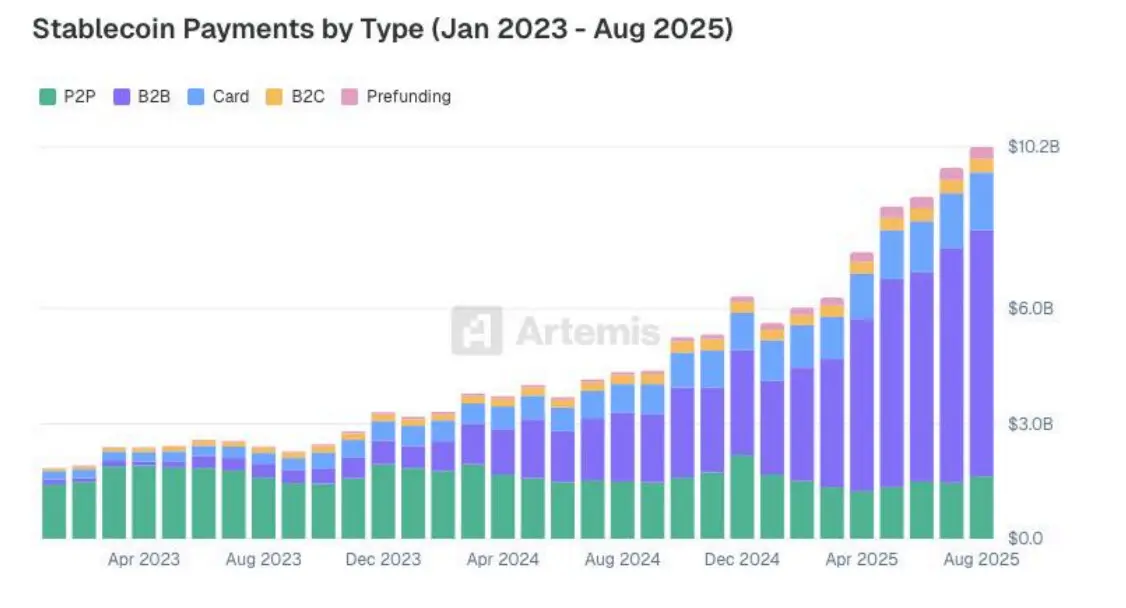Stablecoin payments in 2025 have grown by over 70% since February, driven by B2B transfers and innovative payment solutions. According to data from Artemis, these digital assets now facilitate $136 billion in annual settlements across various sectors, with USDC and USDT leading adoption for efficient, borderless transactions.
-
B2B payments dominate stablecoin usage, accounting for $76 billion annually and enabling large-scale, permissionless settlements between businesses.
-
P2P transfers follow with $19 billion yearly, though they remain smaller in scale compared to corporate applications.
-
Crypto cards have surged to $18 billion in annual volume, reflecting mainstream retail integration with stablecoin balances for everyday spending.
Discover how stablecoin payments expanded 70% in 2025, boosting B2B efficiency and retail adoption. Explore trends, key players like USDC, and future implications for global finance today.
What Are Stablecoin Payments in 2025?
Stablecoin payments in 2025 represent a maturing segment of the cryptocurrency ecosystem, where fiat-pegged tokens like USDC and USDT enable seamless, low-cost transactions for businesses and individuals. These payments have surged by more than 70% since February, fueled by expanded supply, active user growth, and integration into payment gateways. According to Artemis, a prominent crypto analytics firm, stablecoins processed $136 billion in payments from January 2023 to August 2025, highlighting their shift from speculative tools to practical financial instruments.
The evolution stems from clearer regulatory frameworks and technological advancements, allowing stablecoins to bridge traditional finance with blockchain efficiency. Businesses leverage them for cross-border settlements, reducing fees and settlement times compared to legacy systems. This growth underscores stablecoins’ role in fostering financial inclusion, particularly in regions with volatile currencies, while maintaining price stability through reserves in assets like the U.S. dollar.
How Have B2B Payments Driven Stablecoin Growth?
B2B payments have emerged as the primary catalyst for stablecoin payments expansion, offering scalable solutions for high-volume transfers. Artemis reports that these transactions annualized at $76 billion, far outpacing other categories due to their permissionless nature on blockchains. This dominance allows firms to execute large settlements instantly, bypassing intermediaries and minimizing costs—often under 1% per transaction versus traditional wire fees exceeding 5%.
Supporting data from 22 crypto payment providers and interviews with 11 startups reveal B2B’s focus on efficiency. For instance, companies in supply chain finance use stablecoins to settle invoices in real-time across borders, with volumes concentrated in hubs like the USA, Singapore, and Hong Kong. Expert analysis from blockchain consultants emphasizes that this segment’s growth correlates with a 40% rise in stablecoin supply during 2025, enabling more robust liquidity for enterprise applications.
 B2B payments were the most active segment for stablecoin usage. App and card payments expanded in 2025, showing mainstream retail adoption. | Source: Artemis
B2B payments were the most active segment for stablecoin usage. App and card payments expanded in 2025, showing mainstream retail adoption. | Source: ArtemisWhile USDT holds an 85% market share by volume, USDC’s integration with enterprise platforms has accelerated its uptake. Blockchains like TRON process the highest volumes, followed by Ethereum, BNB Chain, and Polygon, each contributing to the ecosystem’s interoperability. This data-driven approach, as noted by Artemis, positions B2B stablecoin payments as a cornerstone for digital finance transformation.
Beyond B2B, other vectors contribute to overall adoption. P2P payments, at $19 billion annually, cater to individual remittances but lag in average transaction size—typically under $500—compared to B2B’s multi-million-dollar deals. These transfers, while convenient, face challenges like regulatory scrutiny and scam risks, where only a small portion of illicit funds is recovered.
Crypto cards represent another growth area, with $18 billion in yearly settlements as of August 2025. Providers like Exa and Gnosis Pay link stablecoin wallets to traditional card networks, mimicking debit card functionality. Monthly volumes exceed $1.5 billion, aligning with average U.S. debit spending patterns and signaling retail mainstreaming. Regulations have eased since 2023, boosting card issuance and usage for everyday purchases.
B2C payments, though smaller at $3.3 billion annually, enable direct merchant settlements, while prefunded solutions handle $3.6 billion for automated payroll and subscriptions. Centralized exchanges play a pivotal role through apps like Bybit Pay and Binance Pay, which onboard millions of users to stablecoin transfers. These tools convert fiat to stablecoins seamlessly, addressing scalability for global operations.
Payment gateways such as BVNK further enhance accessibility by integrating banks with blockchains. Businesses deposit fiat, which BVNK converts to stablecoins for backend processing, leveraging blockchain speed for cross-border payouts. This hybrid model resolves traditional finance’s friction, with BVNK reporting doubled transaction volumes in 2025 amid rising demand from e-commerce and freelancing sectors.
Despite these advances, challenges persist. P2P remains vulnerable to fraud, with stablecoins implicated in scams where recovery rates hover below 20%. Users are increasingly shifting to regulated apps for security, underscoring the need for continued oversight. Overall, the data from Artemis illustrates a market maturing toward practical utility, with stablecoins embedded in diverse payment flows.
Frequently Asked Questions
What Is the Leading Stablecoin in 2025 Payment Volumes?
Tether’s USDT dominates stablecoin payments in 2025 with an 85% market share by volume, according to Artemis data from 22 providers. It powers most B2B and P2P transfers due to its liquidity and availability on major blockchains like TRON. USDC follows as a strong contender, particularly in regulated enterprise settings, processing billions in efficient settlements.
Which Regions See the Highest Stablecoin Payment Activity?
The USA, Singapore, and Hong Kong lead in stablecoin payment volumes in 2025, driven by business hubs and favorable regulations. These areas account for the bulk of $136 billion in tracked transactions, facilitating international trade and remittances with minimal delays. Global adoption continues to spread, but these centers set the pace for innovation.
Key Takeaways
- B2B Dominance: Stablecoin payments in B2B reached $76 billion annually, enabling fast, cost-effective global settlements that traditional systems can’t match.
- Retail Integration via Cards: Crypto cards settled $18 billion yearly, bridging stablecoins with daily spending and showing a 70% usage surge since early 2025.
- Exchange-Led Growth: Platforms like Bybit Pay and Binance Pay have onboarded users to stablecoins, while gateways like BVNK solve fiat-blockchain interoperability for scalable business use.
Conclusion
In summary, stablecoin payments in 2025 have transformed financial transactions, with over 70% growth since February propelled by B2B efficiency and tools like crypto cards. Data from Artemis highlights USDT and USDC’s pivotal roles across blockchains, from TRON’s high volumes to emerging P2P and B2C applications. As adoption deepens, stablecoins promise greater financial accessibility worldwide—businesses and individuals alike should explore these solutions to streamline their operations in an increasingly digital economy.
